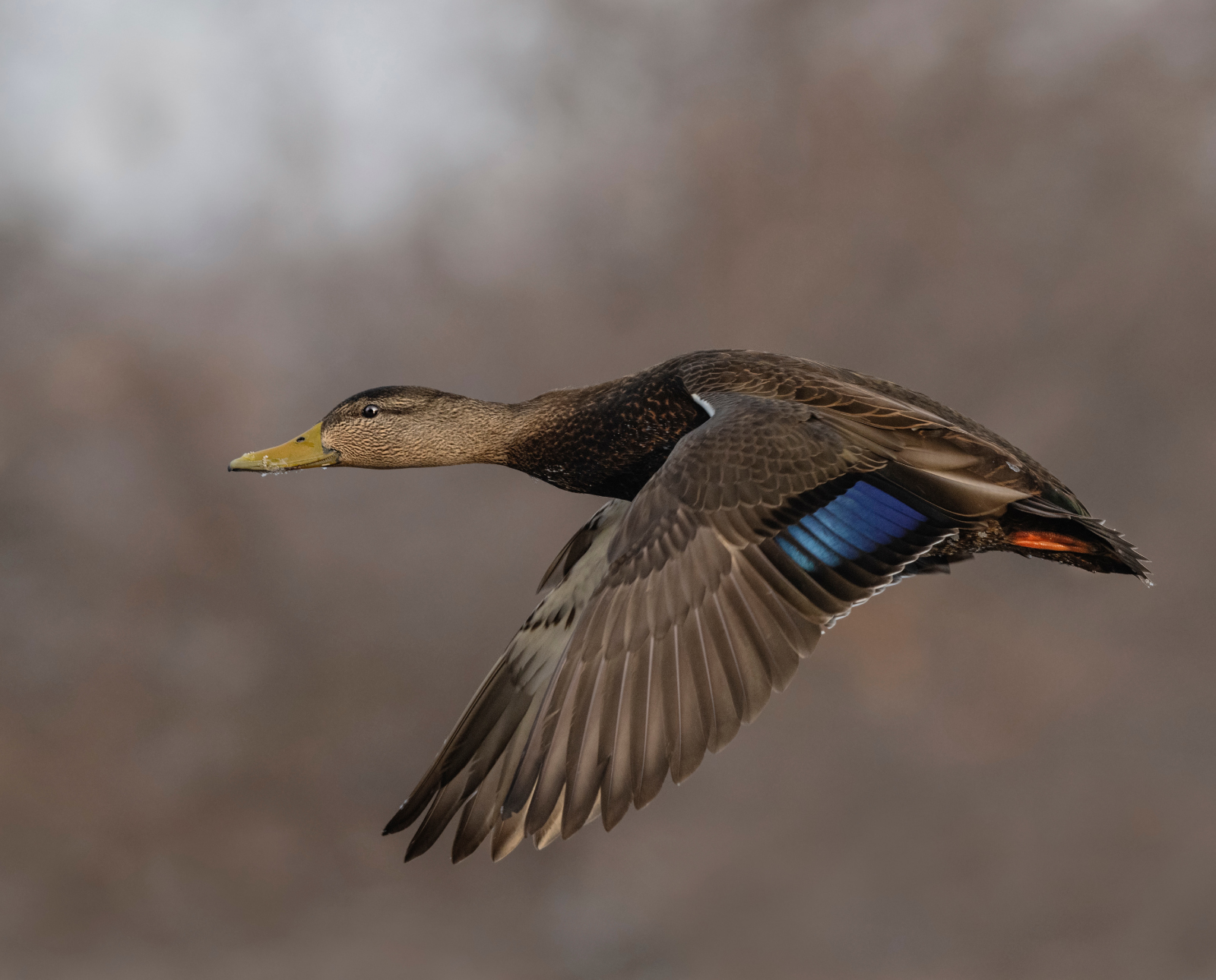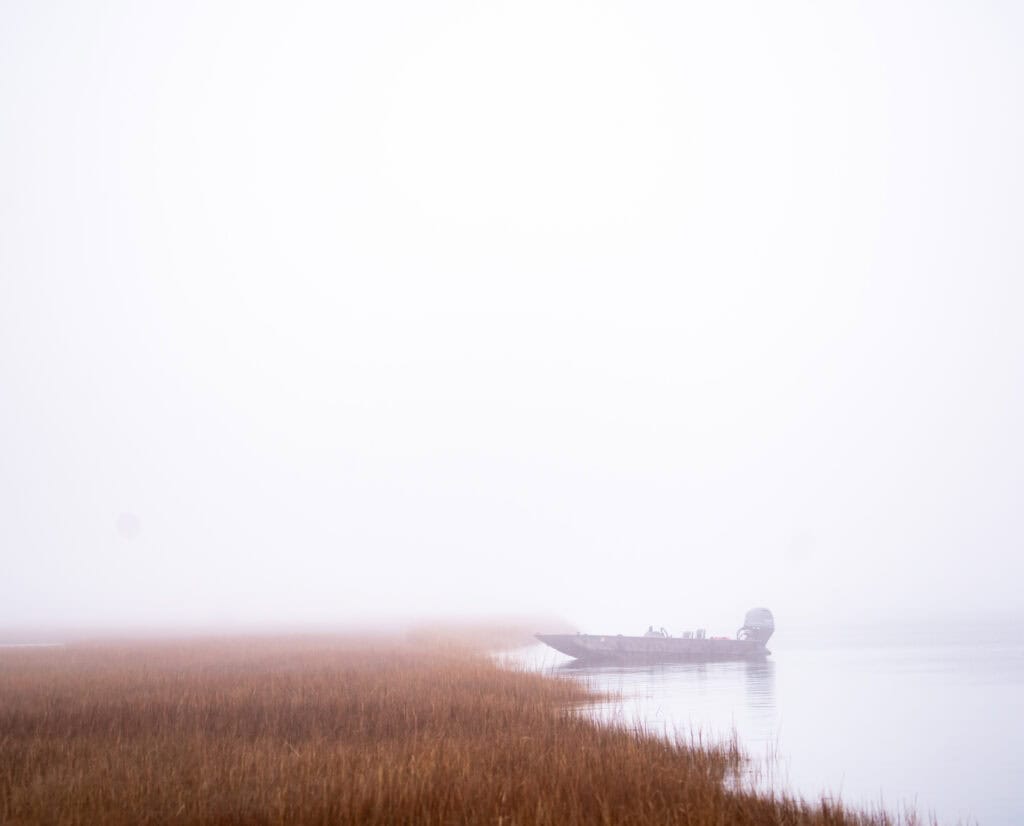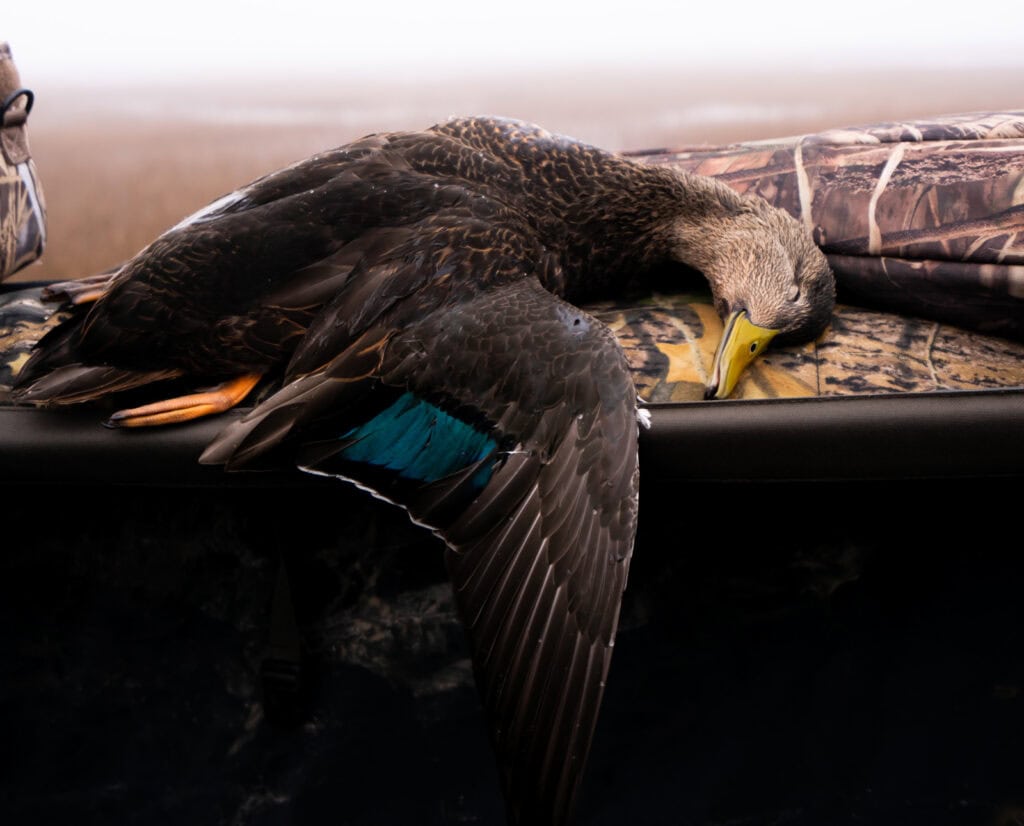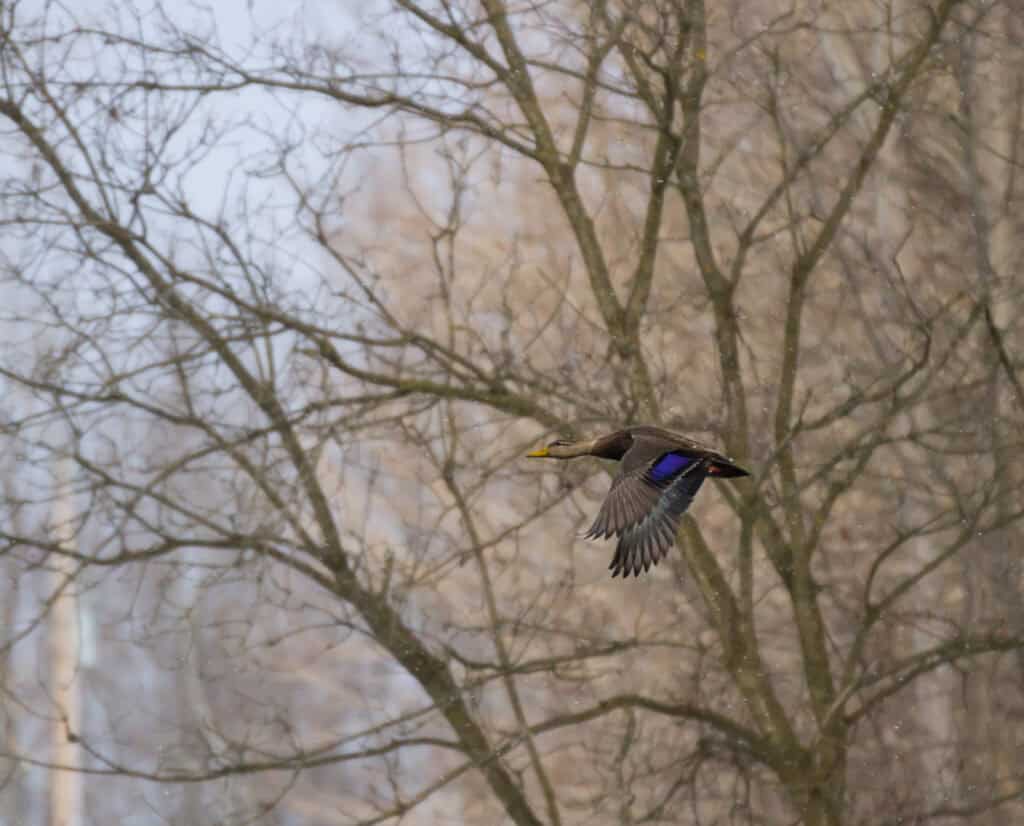Home » Waterfowl Hunting » A Guide to Hunting Black Ducks
A Guide to Hunting Black Ducks

Mike Adams is an outdoor writer, wildlife biologist, and educator…
Habitat, decoy setup, and shotgun recommendations for hunting the ever-wary black duck.
When hunting in black duck country, a thermos full of coffee is mandatory—not for the caffeine or warmth but to keep your spirits up. On the marshes where black ducks live, they make up the bulk of every bird you see. The problem is, they want nothing to do with you.
Listen to more articles on Apple | Google | Spotify | Audible
Of the over two dozen duck species that migrate along the Atlantic Flyway, the American black duck is the only one rumored to be able to count. Too many decoys, and a black duck won’t commit. Too few decoys, and they’ll keep buzzing. The lucky number? Seven, according to old-timers from Long Island Sound. Even-numbered decoy spreads, they insist, indicate a duck hunter.
Now, I can’t attest to the black duck’s ability to count, but I do know they’re tough suckers to hunt. They’re brutally wary. They shy away from most natural-looking decoy spreads, almost always avoid a duck call, and fly in such small numbers that one shot is usually all you get. To avoid heartbreak and frustration, hunters must ditch the usual duck hunting playbook and adopt strategies honed over generations of being outwitted.
Here’s everything you need to know about how to hunt blacks.

Where to Find Black Ducks
If you want to shoot a black duck, there’s no better place to do it than the Cape May peninsula of southern New Jersey. The peninsula and surrounding Delaware Bay marshes winter more black ducks than any other region in the world.
New Jersey hosts over 200,000 acres of salt marsh habitat. During migration, black ducks funnel down a bottleneck formed between the Atlantic Ocean and the Delaware River, terminating in Cape May. Here, tens of thousands of acres of public salt marsh line the coast. Public access abounds, with boat ramps, kayak launches, and walk-in areas.
Read More: How to Select the Right Duck Decoys
Black ducks can be found in fewer numbers elsewhere. The Chesapeake Bay has a large population of wintering black ducks, though numbers dwindle as you move toward the Carolinas. Small populations of black ducks winter in the Great Lakes, Quebec, Nova Scotia, and New England.
While any intertidal zone in the Northeast can offer a chance at a blackie, their preferred habitat exists in clumps. The nastier and muckier, the better. Black ducks favor hellish marsh pockets with bottomless pluff mud. If the marsh looks treacherous—as if you wouldn’t want to walk across it in waders—it’s probably good black duck habitat. Look for even mixes of sedge and open water. The best areas have bulrushes, cordgrass, spikerush, and patchy open water.
While seeds and vegetation make up most of a black duck’s winter diet, they also consume protein-rich foods like snails and fish. Muddy banks and shallow water create ideal conditions for a black duck hooked on seafood. I once hunted a flooded salt hay field and harvested a black duck with a crop that felt like a beanbag. Massaging it, I worked the contents up through the duck’s gullet. Moments later, mystery food gushed from its bill, covering my waders in half-digested minnows.
When they’re not in the gnarliest marshes, black ducks gather in tidal pools, small stream channels, and drainage ditches. Black ducks favor areas where two or more streams converge, often providing the literal and metaphorical X you’re looking for. Hunters, however, must consider the tide.
Read More: Hunting Tidal Creeks for Ducks
During high tide, black ducks like to dig into the thick cover. They slither through flooded grass to feed on seed heads, using the cover to shield themselves from aerial predators. As the tide falls, black ducks retreat to open water, making the falling tide a prime time to hunt along creek channels.
A rising tide, on the other hand, presents an opportunity to hunt tidal ponds. These ponds dry at low tide but flood with a few inches to a few feet of water as the tide rises. Black ducks love to dabble for seeds, snails, and minnows in the newly submerged pluff mud. A smart black duck hunter would set up along the edge of one of these ponds at high tide with a minimalistic spread of three to six decoys and the wind at their back.

Black Duck Hunting Gear
Since black ducks favor the roughest, hardest-to-reach pockets of the marsh, black duck hunters need gear built for the task. For starters, black duck hunters benefit from a boat suited to tidal marshes. The top choice, responsible for putting the most black ducks into hunters’ freezers, is the Barnegat Bay sneakbox. Low-profile, flat-hulled, and crafted from featherweight fiberglass, sneakboxes navigate all tidal conditions. They allow hunters to hide along stream channels, tuck into mosquito ditches, and even paddle into tidal ponds with less than a foot of water.
Alternatively, an old-school tactic involves grassing up a kayak and hauling it out on an aluminum jon boat. Jon boats offer deep public land access, while kayaks provide stealth. As you approach the hunt area, anchor the jon boat to the bank and paddle the kayak into a promising black duck hellhole. Wedge into some grass and wait.
As teenagers, my buddies and I opted for an even more primitive method. Using natural cover along a river channel, we’d hunker into the marsh, neoprene-covered butts in the mud, feet nearly dangling in the water. With enough cover, it works.
Whether it’s a jon boat, kayak, sneakbox, or waders, all these methods are low profile. The less commotion, the better when hunting black ducks.
I hesitate to label hunting dogs as gear, but I hesitate even more to omit them from the conversation. Black duck hunters benefit greatly from a dog with a good nose. Black ducks haunt nasty, muddy, unwalkable areas, making wounded birds extremely hard to find. Additionally, some salt marsh habitats have grass as thick as a muskrat’s fur, and wounded black ducks, with their strong survival instincts, lay belly down in it, becoming nearly invisible. A bird dog’s sense of smell saves hunters from long, fruitless searches.
Read More: How to Introduce a Dog to Water Work
When I’m black duck hunting, I bring my Golden Retriever and extra water for those long searches. Sometimes, finding a wounded bird can take an hour. If you’re hunting without a dog, be selective with your shots. Few things sting more than fooling a black duck, only to lose it to the marsh.
Shotguns and Shot Size Recommendations For Black Duck Hunting
A typical black duck setup includes a 12- or 20-gauge shotgun and shot sizes ranging from 2 to 6. I consider two factors for shot size. First, black ducks are large—sometimes nearly the size of a small goose. Second, shot opportunities are fleeting. Black ducks rarely commit to decoys with the cupped, locked-wing look on waterfowling magazine covers. For insurance—both in downing large birds and in forgiving imperfect shots—I prefer shot sizes closer to 2.
Semi-automatics are popular with duck hunters, but I find pump actions work well for black ducks. Unlike in the rice fields of Louisiana, where teal stool in by the hundreds, black ducks typically fly in singles or pairs, eliminating the need for rapid, instinctive shots. Pump actions encourage hunters to slow down and carefully aim each shot.

Black Duck Hunting Strategies
You can’t hunt black ducks without first being able to identify one on the wing. Fortunately, black ducks make it easy. The white underside of their wings contrasts with their charcoal-colored bodies. Even from hundreds of yards away, that pulsing flash of white unmistakably marks a black duck.
If the color doesn’t give it away, the bird’s behavior will. Teal, pintail, mallards, and other ducks stool into decoys with little hesitation, but black ducks are cautious. They scrutinize decoy spreads with the thoroughness of a football coach studying a defensive formation. Any imperfection—a shiny face, decoys touching, a dog twitching—will make them spook.
Concealment
For the best odds of harvesting a black duck, grass up and then grass up again. Hide your face and watch your movement. I use a mixture of natural cover paired with grass mats that I bring out to cover the boat, motor, and anything else left exposed. I also wear a facemask or cover my cheeks with the soot of a burned cork stopper. Faces shining in the morning sun scare more black ducks than anything else.
Black ducks give themselves time to find any flaw in your set up. They will circle once, twice, and sometimes three times before locking their wings. Even more likely, black ducks will circle your spread, then peel off without ever flaring. You’ll scratch your head wondering what went wrong, but typically there is no answer.
Black ducks are to fool. Good black duck hunters will always take their shot as soon as an opportunity presents itself.
Replicate Black Duck Behavior
Another reason black ducks are hard to hunt is that they aren’t particularly gregarious. They rarely fly in flocks, and when they do, it’s usually with other black ducks.
In black duck country, tailor your strategy to their loner habits. Use only a few decoys. While some hunters swear by seven, I prefer three to six. For extra accuracy, avoid mixing species. Other ducks may commit to a flock of black ducks, but black ducks rarely join flocks of other species.
Black Duck Calls
I usually feel in control with a duck call, but with black ducks, calling nearly always backfires. Calls typically do more harm than good, so leave them in your wader pocket or stick to single quacks.
Old-timey wisdom may seem overly simple, but it’s often true. Generations of black duck hunters give the same advice: the best way to fool a black duck is to be where the birds want to be before they get there. After that, it’s all about staying hidden, crossing your fingers, and sipping coffee when times get tough. But when
Mike Adams is an outdoor writer, wildlife biologist, and educator hailing from salt marshes of the mid-Atlantic. His work has appeared in numerous outdoor publications, where he uses hunting and fishing narratives to explore deeper issues in conservation or ecology. In the fall, you'll find him on his Barnegat Bay Sneakbox hunting ducks with his dog, Boone. Any other time of year, he's usually out on the salt marsh, catching crabs or fishing for striper.



